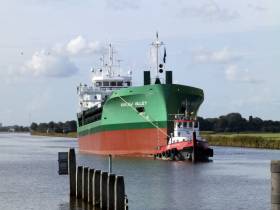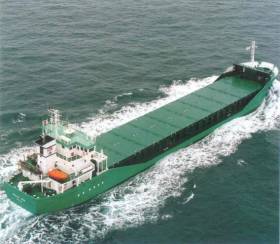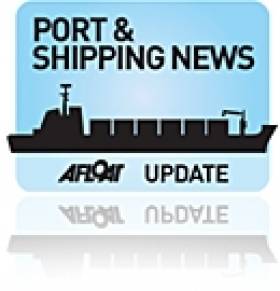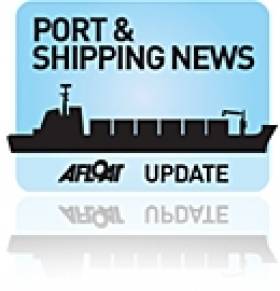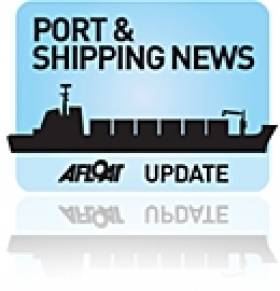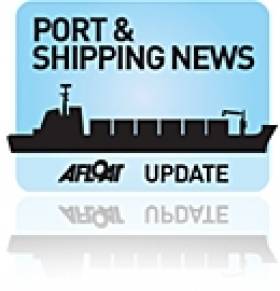Displaying items by tag: Arklow Shipping
Ferry Due from Wicklow Yard While Arklow Dutch Built Cargoship Makes Sea Trials
#SeaTrials - As a new car ferry is to be launched in Co. Wicklow yard as previously reported, an Arklow Shipping Dutch flagged and built cargoship is making first sea trials today, writes Jehan Ashmore.
The Royal Bodewes newbuild no 724, Arklow Valley, a cargoship with a modified bow design compared to her more distinctive sisters to improve energy efficiency, had been transported yesterday under tow. This involved a pair of tugs to take the near 87m long newbuild from the inland shipyard near Groningen to Delfzijl.
Further along the coast at Eemshaven, is where Arklow Valley had sailed to and this afternoon the newbuild was in the open sea off the Western Frisian Islands in the North Sea.
She is the fourth so far completed from 10 in a series of 5,100dwat Bodewes Traders on order to ASL. They will be part of Arklow Shipping Nederlands B.V. with an office located in Rotterdam.
The new series or ‘V’ class are all Dutch flagged and began with leadship, Arklow Vale. The single hold vessel was launched and named just over a year ago, by ships godmother, Mrs Mari Louise de Jong.
Irish-Dutch Cargoship Sold to UK Owners Based in Wales
#ShipSold - As Arklow Shipping continue a shipbuilding spree to replace ageing tonnage, one of their oldest ‘R’ class short-sea cargoships has been disposed, writes Jehan Ashmore.
Built in 2002 the Arklow Rose of 2,999 gross tonnage which as previously reported on Afloat.ie was at Cork Dockyard, Rushbrooke, part of the Doyle Shipping Group (DSG), has since been renamed Celtic Venture.
Of the near 50 strong joint Irish-Dutch flagged fleet (that includes deepsea bulkers), the 90m Arklow Rose was registered in Rotterdam where ASL’s division, Arklow Shipping Nederland B.V. is located.
The cargoship has transferred flag to the UK for owners, Charles M. Willie & Co. (Shipping) Ltd of Cardiff, Wales. The shipowner, managers and charterer company was established in 1912 with origins as coal exporters and timber (pit props) importers.
Having been alongside Cork Dockyard’s layby quay since 20 August, the vessel has re-entered the graving dock yesterday and where among the work been carried out is on the propeller blades.
Also confirmed with the new owners in that a former Celtic Venture in March was sold to Turkish owners. Afloat.ie has monitored the vessel this week in the Mediterranean which sails as Tahsin Imamoglu with a port of registry in Istanbul.
In between Arklow Rose drydocking and her return under a new name, was the Naval Service flagship HPV LE Eithne (P31) which vacated the facility also yesterday.
First of New Design ‘Arklow’ Cargsoships from Ferus Smit
#NewCseries - The first in a new class of 10 cargoships for Arklow Shipping under construction near Groningen, Netherlands is to be launched next month and follows a series of a different design built by the same yard, writes Jehan Ashmore.
Launching of leadship newbuild no. 424 Arklow Cadet (also a new name for ASL), a ‘C’ class cargoship with a capacity of over 5,000dwt is to take place at Ferus Smit’s Dutch yard at Westerbroek.
The facility in north-east of the country is where newbuild no. 435 M.V. Ireland was christened (for non-Irish owners) in March as seen in footage previously featured on Afloat.ie. Note on the left of the screen is a green coloured hull mid-section of Arklow Cadet between the builder’s hall and that of M.V. Ireland before launching.
The newbuild represents the first under construction at the Dutch yard for ASL since Arklow Breeze became the final of six ‘B’ class 8,860dwt series. This newbuild no. 414 was launched in March 2015 and entered service the following month. Of the current fleet of 45 cargoships ranging from 4,200-35,000dwt, only 10 vessels date to 2004 or earlier.
Likewise of the Arklow Cadet the ‘B’ class have hulls form chosen to adapt the ‘bulbless’ principle thus creating a slender bow without bulb.
Arklow Cadet has one single hold volume of 220.000 cft. The C class have a 1A iceclass notation and they are propelled by a 1740 kW MaK engine with a single ducted propeller. Delivery of Arklow Cadet is scheduled for July of this year.
Another Dutch yard, Royal Bodewes in Hoogezand which is only several kms away from Ferus Smit continues to roll-out the ‘V’ class series of 10 Eco-Trader 5,100dwt newbuilds. The latest fourth newbuild's stern section was recently removed out of the builder's hall to the outfitting quay.
The V class are managed by Arklow Shipping Nederland B.V. based in Rotterdam and among the bulk dry cargoes they transport they include grain, animal feed and steel rails.
The last completed sister newbuild no. 723, Arklow Valiant launched at the end of March. This week the newbuild was towed down the canal to reach Delfzijl from where sisters have undergone sea-trails.
#TheTyrrells – Fifty years ago Arklow Shipping was formed, following the amalgamation in 1966 of three independent shipowning families from the east coast port in Co. Wicklow, writes Jehan Ashmore.
The families, Tyrrell, Kearon and the Hall’s all had origins directly in trading auxiliary sailing schooners from the banks of the River Avoca that flows through Arklow into the Irish Sea. The era of the days of sail trading were coming to a close during the 1950’s and ‘60’s as motorised coasters were increasingly taking over from the traditional schooners of the single-ship owners.
It was felt in certain quarters that such practises needed to be overhauled so to compete. This led to a co-operative which removed inefficiencies of the independent shipowners and instead by pooling resources to reduce costs.
The decline of the schooners by more efficient coasters led to the last Irish Sea schooner, De Wadden disposed. The vessel remains on display at the Merseyside Maritime Museum, Liverpool.
In the earliest formation to pool resources, the Arklow shipowners acquired a 12 year old German ship. The vessel had been taken as a war prize in 1945 by the British Admiralty and was sold in 1947 to trade with the Arklow families and renamed Tyrronall.
The coaster, Tyrronell derived its name from three letters chosen from the family surnames. The co-operative progressed when in 1966, Captains James Tyrrell, Michael Tyrrell and Victor Hall formed an umbrella company, Arklow Shipping under which together operated seven ships.
Under the following ship-owners: James Tyrrell Ltd contributed vessels (Darell, Valzell, Mariezell and Murell), Captain Michael Tyrrell (Avondale), Captain Richard Hall (River Avoca) and George Kearon Ltd (Reginald Kearon and Gloria). Of this initial fleet, all but two were managed by ASL.
It was not until 1970 that officially the company, Arklow Shipping Ltd was formed and over the next five decades, ASL have acquired numerous second-hand tonnage and ordered series of custom built vessels, notably from yards in the Netherlands, Spain and Korea.
The vessel naming nomenclature is now based on a nominated letter. i.e. the latest is 'V' for the recent newbuild series, in which Arklow Valiant was launched last month. This vessel is the third of 10 newbuild 5,100dwat tonnes general cargsoships completed by Dutch yard, Royal Bodewes.
Asides the newbuild, the fleet total is 45-strong and ships are either general dry-cargo traders or bulk-carriers. The smallest series in the fleet are the 'R' class, for example, Arklow Rose of 4,933dwt to the largest 'S' class bulkers, the Arklow Spray of 34,905dwt. Both vessels are Irish flagged and unlike the newbuilds will be Dutch flagged under Arklow Shipping Nederland B.V.
Across the ASL fleet, they transport a variety of cargoes among them in the bulk grain trades, steel rails, minerals, generals and containers.
The trading area is mostly north-western Europe though the bulk-carriers operate on international deep-sea trade routes.
First ‘Valiant’ Makes Her Launch Splash for Arklow
#Valiant – Following our pre-launch coverage of Arklow Valiant, the above footage shows the third Royal Bodewes newbuild make first contact with the water at the Dutch yard for Arklow Shipping, writes Jehan Ashmore.
Newbuilding 723 was launched from the quayside at the yard in Hoogezand, Groningen, last Friday for ASL’s Dutch division, Arklow Shipping Nederland B.V.
The single-hold 5,150dwat cargoship will became the 17th Dutch-flagged vessel out of the total fleet of 46 ships which are otherwise Irish-flagged.
Notably, she also differs to her completed 5,100dwat Trader sisters, Arklow Vale and Arklow View, in terms of an efficient and cost-effective straight stem bow design.
She is the first vessel in the Arklow fleet to be named ‘Valiant’ in the series also known as the V class. Over the decades there have been previous V class generations that have carried names among them, Valour, Venture and Villa.
The christening of Arklow Valiant will be performed at a handing over ceremony in the port of Delfzijl that is reached from the inland yard by canal. Delfzijl is where Arklow View was also named.
Unlike last year's launch of leadship Arklow Vale where the naming was carried out at the Hoogezand yard.
Arklow Newbuild Begins Career With Maiden Voyage
#MaidenVoyage- Arklow Vale, the newest addition to Arklow Shipping's Dutch division has been handed over to her owners following builders sea trials, writes Jehan Ashmore.
The newbuild departed Delfzijl on her maiden voyage to the inland port of Ghent in neighbouring Belgium.
The leadship of 10 newbuild 'V' class cargoships on order from Royal Bodewes yard in the Netherlands, Arklow Vale now joins the Arklow Shipping Nederland B.V. fleet. She is to a design of the Bodewes 5,100dwt Trader Series and has a total hold capacity of 6258m3 / 221,000ft3.
Last week, Arklow Vale which is 89m (length overall) and has a gross tonnage of 2,999 carried out sea trials off Eemshaven on the Wadden Sea.
In order for sea trials to take place the Arklow Vale was towed from the the inland building yard of Royal Bodewes in Hoogezand outside Groningen and along connecting canals to Delfzijl. From there the Rotterdam registered newbuild entered the River Eems estuary on the Dutch-German border.
The distinctive bow of Arklow Vale has a straight-stem that slices the waves coupled by an upper slope to deflect wave resistance. In all the design is to reduce on energy costs.
A main engine consisting of a MaK 6M25 1740 kW with Siemens Gearbox and Berg controllable pitch propeller provides a speed of around 14.5 knots.
#FinalGreen – Arklow Breeze has been chosen as the name of the final of six 8660dwt newbuilds that features a cargo hull designed with 'green' credentials, writes Jehan Ashmore.
The slender sharp hull lines of newbuild (no. 414) are to be launched on 20 March from Ferus Smit B.V. Westerbroek. The Dutch yard is also where her 'B' theme named sisters: Bank, Beach, Bay, Beacon and Brave were completed for Arklow Shipping subsidiary Arklow Shipping Netherlands B.V.
The series leadship, Arklow Bank which called to Dublin Port last month was completed a year ago. The 'bulb-less' hull forms part of her 'green' design is to reduce wave resistance while not compromising on cargo-loads. The vessels two-hold grain capacity is 9902,6m³ and for bale of 349.706ft³ . For further details click the above link.
Arklow Breeze is a bulk oriented general cargoship that ASL will mainly employ in the shipment of wheat, corn and other bulk commodities in European waters.
Leadship ‘Bank’ Berths Along Dublin Port’s South Bank
#ArklowLeadship – Afloat.ie has followed the progression of Arklow Shipping's series of 'B' class newbuilds almost a year ago to the day and that of leadship Arklow Bank which departed Dublin Port yesterday, writes Jehan Ashmore.,
Arklow Bank is the first of six in a series of cargoships ordered for ASL's Dutch division, Arklow Shipping Netherlands B.V. The leadship newbuild was delivered into service in early 2014 from shipyard, Ferus Smit B.V. of Westerbroek.
Flying the Dutch flag, the Rotterdam registered 8,660 total dwt cargoship had arrived from Spain to Dublin Port to berth along the port's south bank quays on Monday evening.
The previous port of call is understood to be from Gijon, however Afloat.ie can confirm that the cargo on board was granulated slag in bulk.
The quay at the Deepwater Berth (locally referred as the 'Coal' Quay) is also where scrap metal is a main trade carried out along this part of the port. It is also where a crane is dedicated in the memory of the famous musician Ronnie Drew of The Dubliners.
A Coops & Nieborg pontoon system operated the hatch covers of the 119m long hull which has a 'bulb-less' bow and a hull form designed with 'green' credentials.
By examining the slender hull while alongside the newbuild, the fresh sharp waterlines could be seen and notably that of her straight-stemmed bow.
Both the design of the bow and hull combined are to reduce wave resistance even in rougher conditions and while not compromising on cargo load volumes.
She is classed with Bureau Veritas and has a two-hold grain capacity of 9902,6m³ and for bale of 349.706ft³ .
Powerplant is sourced from a Mak engine delivering a maximum 13 knots.
To date the Arklow Bank has been joined by a quartet of sisters with a final unit to complete the series. In the meantime, it was business as usual as the 'Bank' departed yesterday afternoon bound for Porsgruun in Norway.
Arklow’s New ‘Green’ Cargoship Makes Maiden Call to Capital
#MaidenPortCall - Arklow Beacon, made her maiden port of call to Dublin Port this weekend, the second newest 'B' class dry-cargoship of the Arklow Shipping fleet, had docked loaded with slag from Spain, writes Jehan Ashmore.
The 8,660 dwt Arklow Beacon's voyage across the Bay of Biscay began on Friday having departed Gijón in the Asturias region which forms part of 'Green' Spain.
She is the latest of six sisters, noting that second ship, Arklow Bay featured on Afloat.ie with a video voyage showing spectacular scenery of the Norwegian fjords.
Arklow Beacon has no bulbous bow, but to retain hull efficiency, her 119m hull form is optimised with 'green' credentials without compromising on cargo loadings. In addition the ships slender hull is designed to perform in varying sea-states.
As previously reported here on Afloat.ie, Arklow Beacon was launched last September and she began her career the following October.
She along with her sisters, were ordered for ASL's Dutch subsidiary, Arklow Shipping N.V. based in Rotterdam. It is also in the same country as to where the newbuilds were contracted to Ferus Smit's shipyard in Westerbroek.
The series are not to be confused with a pair of other ships beginning with 'B' names, the Arklow's 'Bridge' and 'Brook'. This pair were also Dutch built but by another yard, Bodewes Shipyards B.V. in 2011 and are in fact differently designed having a deadweight of 7,575 tonnes.
ASL 's combined fleet of Irish and Dutch flagged ships totals 45 vessels to date, the majority are registered in Arklow. The largest series in the fleet are those of the 'R' class series which number 15 vessels.
These 4,399dwt ships were all custom-built during 2002-2007, however what makes them differ to their fleet-mates is that they are the only same-ship series to fly both the Irish and Dutch flags.
Another Arklow ‘Green’ to Enter a Brave New World
#ArklowGreenNewbuild – Arklow Shipping's latest B class newbuild with 'green' credentials, Arklow Brave which is designed with a bulb-less hull form is to be christened and launched next month, writes Jehan Ashmore.
Arklow Brave follows a quartet of bulk orientated general cargo ships sisters, starting with leadship Arklow Bank launched in January from the Ferus Smit B.V. Netherlands shipyard in Westerbroek.
At 119m in length, Arklow Brave's slender bow form which also features a straight stem is designed to take into account the various loading drafts and wave conditions. She and her sisters are to be deployed in the shipment of wheat, corn and serve in other bulk commodity markets.
When the 4,800dwt Arklow Brave which is scheduled for launching on 12 December makes contact with the water, this will present a spectacular spectacle, given the yard's procedure of launching amidships or sideways. An example, being her predecessor, Arklow Bay... click HERE for report and footage!
The launch onto the waterway of Arklow Brave will represent the fifth out of a total of six B class ordered for the Irish company. She will serve under their Dutch based division, Arklow Shipping Netherlands N.V.
As previously reported on Afloat.ie, Arklow Bay which called to Dublin Port in late October, has returned in recent days and she is currently berthed at the Deep Water Berth (Coal Quay) along the south quays.
The newbuild on her previous call to the port had docked at the Boliden Tara Mines Ltd jetty which has a conveyor-belt loading system to transfer the zinc and ore cargo on board having arrived to the port by train. She then headed for the Norwegian smelting works at Odda.
Alongside the jetty today is a larger fleetmate, Arklow Willow at 14,001dwt albeit in a lay by capacity following routine maintenance in dry-dock that was carried out by Dublin Graving Docks Ltd.
When Arklow Brave is delivered to her Rotterdam based subsidiary, she will be part of a 46-strong fleet that includes a majority of Irish-flagged ships that carry cargoes mostly throughout northern Europe.



























